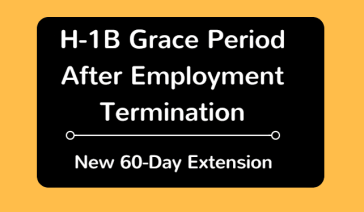H-1B Grace Period: What is it?
 We have received a good number of questions about the grace period afforded to H-1B visa holders recently, so I thought I would go through the grace period and what it covers. We discussed this previously in this blog post but this post will clarify and expand on exactly how the grace period works.
We have received a good number of questions about the grace period afforded to H-1B visa holders recently, so I thought I would go through the grace period and what it covers. We discussed this previously in this blog post but this post will clarify and expand on exactly how the grace period works.
Who is Eligible for the Grace Period?
First, the grace period we are talking about is for those currently in the US in H-1B status who, for one reason or another, are unable to continue working for the employer that sponsored them, and have not yet filed an H-1B application to switch to a new employer. (technically it also applies to those in H-1B1, L-1, O-1, E-3 and TN status as well). Prior to the change in rules (about 3 years ago) people who fell into this category would be considered to be out of status and, if they filed a new H-1B application, it was really up to the individual officer if they would excuse a certain number of days out of status when adjudicating the extension of status application. USCIS decided to standardize the grace period and provide guidance on how it worked.
How Long is the Grace Period?
The grace period is for a MAXIMUM of 60 days. This means that it is not necessarily going to be the same length of period for each person. The reason for this is that the grace period cannnot extend your ability to stay in the US past the date listed on your I-94. So, if today is December 1, 2019, and your H-1B is set to expire on December 3, 2019, you would only get 2 days in your grace period. Someone else whose I-94 is not set to expire until June 1, 2020, would get the full 60 days if needed, as they have more than 60 days left on their I-94.
What Can you Do During the Grace Period?
During the grace period, you are able to file a change of status application, file a new H-1B application for another employer or even file an adjustment of status application. It is as though you are still in H-1B status during that period and you are able to do anything (immigration wise) that you could do if you were still working pursuant to your H-1B.
What About Dependents?
Any dependents in H-4 status are also authorized to stay during the grace period. In addition, as you are still considered to be in H-1B status, any EAD granted to an H-4 holder will also remain valid during the grace period.
How Many Times Can I use the Grace Period?
You are only eligible for one grace period per authorized validity period. This means that if you are with Employer A and are fired, use 10 days of the Grace period and then are rehired by Employer A under the previous H-1B, you CANNOT use the grace period again during that H-1B, even if Employer A fires you again. Conversely, if, instead of going back to work for Employer A, you work for Employer B instead, and Employer B then fires you, you would have a new 60 day grace period.
Do I have to File an Application with USCIS in order to use the Grace Period?
No, the grace period works as a matter of law – the day after your last day of work it automatically begins. This also means that USCIS cannot deny the grace period to a given person as it applies in ALL cases that meet the criteria listed.
What if I am not fired, but, instead I quit my job?
The grace period is available for any H-1B holder who stops working during the validity period of their H-1B regardless if it is because they are fired or because they quit.
I have tried to answer most of the questions that we have seen in relation to the H-1B grace period. If you have any additional questions, please do not hesitate to contact us.
Remember, if you need legal advice talk with an attorney, not a blog post.